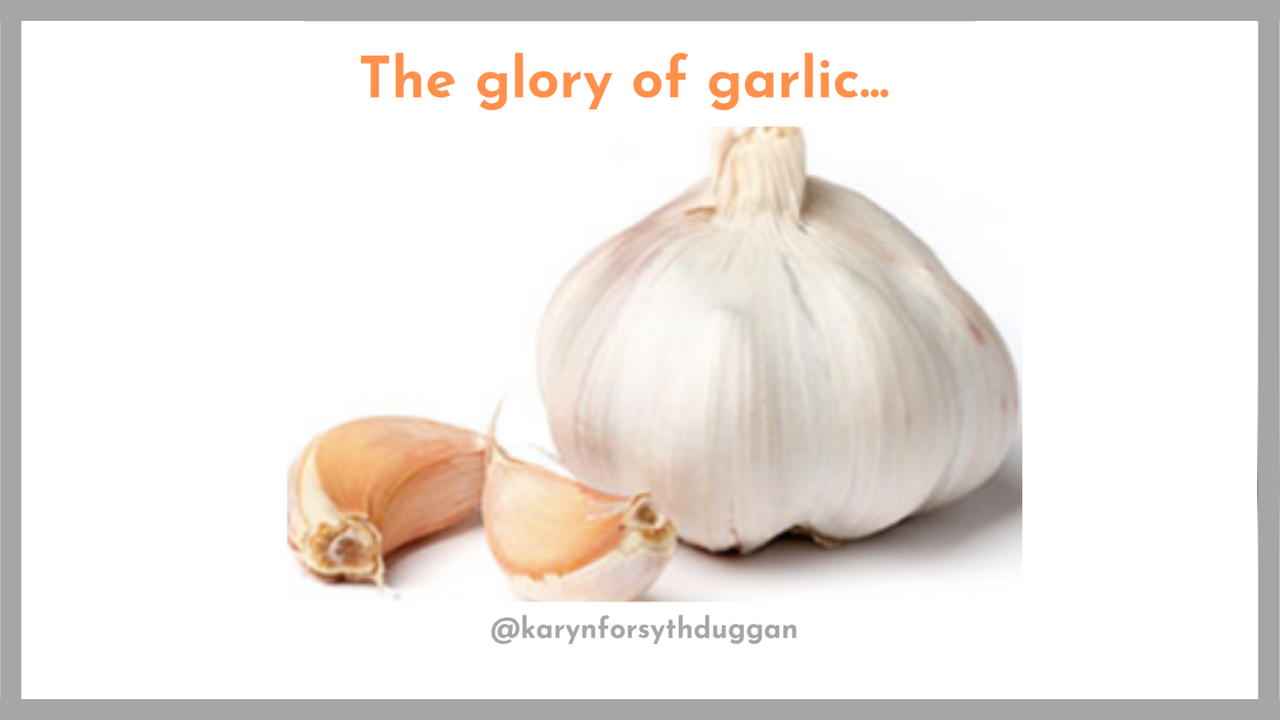The glory of garlic

Allium sativum - the botanical name for garlic - is said to be ‘strong enough to battle heart disease’ according to Aggarwal (2011); he considers it “one of the world’s most potent natural medicines” (p. 122). The distinct aroma of garlic is due to its most active ingredient allicin.
Fascinating facts about allicin...
-
If you’re not as fascinated, and perpetually impressed, by nature as I am, just skip ahead to the beneficial actions... Allicin is only released when a garlic bulb is cut or crushed, i.e., the sulphur-containing compound alliin is enzymatically converted, by allinase, into allicin only when the bulb is ‘interfered with’... This suggests that it’s a sort of defense mechanism against microbial pathogens in the soil…”invasion of a garlic clove by fungi and/or other soil pathogens causes the interaction between alliin and allinase which rapidly produces allicin which in turn inactivates the invader” (Josling, 2005, p. 21).
Beneficial actions of garlic...
-
Allicin, which is released when garlic is cut/crushed, is a potent anti-microbial, in its pure form allicin has been found to exhibit (1) anti-bacterial activity against a wide range of bacteria, (2) anti-fungal activity (including against Candida albicans), and (3) anti-parasitic activity (Ankri & Mirelman, 1999).
-
Multiple studies demonstrate garlic’s extensive cardiovascular benefits from lowering blood pressure (Ried & Fakler, 2014), thinning the blood, lowering total cholesterol, preventing plaque accumulation, to increasing flexibility of arteries, and as a result overall lowering the risk of a heart attack (Ginter & Simko, 2010).
-
In addition, according to Majewski (2014), garlic has also been clinically evaluated for treatment of the common cold, diabetes, and rheumatoid arthritis as well as the prevention of atherosclerosis and development of tumors.
Why you should (and how to) include raw garlic in your diet...
-
Fresh, raw, garlic has been shown to have more of an anti-inflammatory effect compared to cooked/heated garlic (Shin, et al. 2013), however, may people don’t like the idea of eating raw garlic...but that’s where a little creativity in the kitchen is crucial!
Consider trying either of these recipes the next time you’re trying to fight off a cold, or working to navigate any of the aforementioned conditions:
-
Gremolata (which is a delicious addition to any meal, especially grilled fish/chicken
-
Kitchen cautions & comments:
(1) DON’T store garlic in olive oil at room temperature unless you fancy a dose of botulism....
Clostridium botulinum - the bacteria sports that cause botulism - can spread in certain foods when not exposed to oxygen, the chilling process slows this process down but doesn’t prevent it completely...so if you don’t use all your garlic oil immediately store in your fridge but use it within ~5 days.
(2) Be careful when browning garlic - burning makes it bitter...always add it after your onions to avoid burning, and cook it for just 1 minute, no more, before adding other ingredients.
(3) Elephant garlic doesn’t pack the same level of flavor as a normal size garlic, as a result many chefs recommend using it in the same way you’d use a leek.
(4) The therapeutics benefits associated with freshly chopped/crushed garlic don’t last forever...so use your chopped/crushed garlic within ~12 hours to avail of these benefits. FYI - it’ll still taste fine after 12 hours you just won’t be getting all the benefits.
References:
Aggarwal, B. B. (2011). Healing spices: How to use 50 everyday and exotic spices to boost health and beat disease. New York, NY: Sterling.
Ankri, S. & Mirelman, D. (1999). Antimicrobial properties of allicin from garlic. Microbes and Infection, 1(2), 125-129. https://doi.org/10.1016/S1286-4579(99)80003-3
Ginter, E., Simko, V. (2010). Garlic (Allium sativum L.) and cardiovascular diseases. Bratislava Medical Journal, 111(8), 452-456. https://www.ncbi.nlm.nih.gov/pubmed/21033626
Josling, P. (2005). Alicin: The heart of garlic, nature’s aid to healing the human body. Chicago, IL: Allimax Nutraceuticals
Majewski, M. (2014). Allium sativum: facts and myths regarding human health. Rocz Panstw Zakl Hig, 65(1), p. 1-8. https://www.ncbi.nlm.nih.gov/pubmed/24964572
Ried, K. & Fakler, P. (2014). Potential of garlic (Allium sativum) in lowering high blood pressure: mechanisms of action and clinical relevance. Dove Press: Integrated Blood Pressure Control, 7, 71-81. doi: 10.2147/IBPC.S51434
Shin, J. H., et al. (2013). Short-term heating reduces the anti-inflammatory effects of fresh raw garlic extracts on the LPS-induced production of NO and pro-inflammatory cytokines by downregulating allicin activity in RAW 264.7 macrophages. Food Chemistry Toxicology, 58, 545-551. doi: 10.1016/j.fct.2013.04.002


